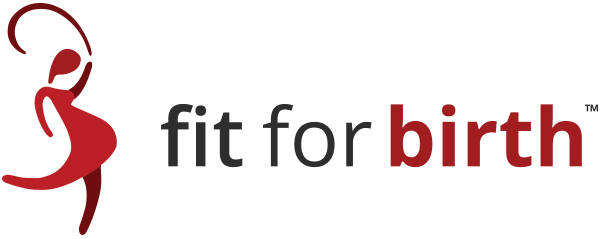Postpartum Rib Flaring, Thrusting & Stacking
Concepts for Fitness Professionals
[Last updated 2/12/25]
The position of your client’s ribs, particularly in postpartum bodies, can play an influential role in your programming as a pre & postnatal fitness professional. Terms like rib flaring, rib stacking, rib thrusting and ribs down posture have been overlapping in the pop fitness realm, providing a need for clarification. This article serves to clarify these terminologies and make it simpler for you to create appropriate regressions and progressions for your clients.
Let’s begin with three potential definitions for “Rib Flaring”:
- Rib Thrust
- Ribs Tipped Up Flare
- Infrasternal Rib Flare
We will discuss each below.
RIB THRUSTING
Rib thrusting is not necessarily the same as true rib flaring. It is simply a postural position of over-arching the spine, as can be commonly seen in a client lifting a weight over her head. In a rib-thrust posture, it is likely to find your client in an anterior pelvic tilt position (“tail up”) along with an over-arched back.
The solution for rib thrusting can be as simple as practicing the posterior pelvic tilt (“tail under”), while simultaneously activating the upper abs and external obliques to keep the ribs down. Especially when raising the arms overhead, teach your clients to keep their ribs from thrusting, thereby keeping the “rib down” posture.
| Solutions for Rib Thrusting |
|
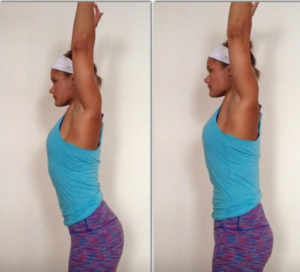
RIBS TIPPED UP FLARE
In a Ribs Tipped Up Flare, the cartilaginous parts of the lower ribs have actually changed position. Relative to the rest of the skeleton, a ribs tipped up flare means that a structural change has occurred, one that can be hardly noticeable or quite dramatic.
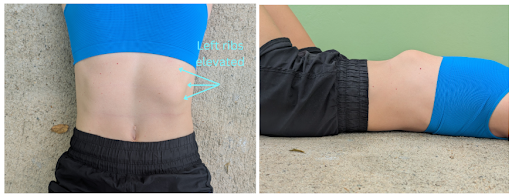
INFRASTERNAL/SUBCOSTAL RIB FLARE
Infrasternal/Subcostal Rib Flare is when the “fixed” angle that the left and right sides of the ribs separate beneath the sternum becomes “permanently” wider than about 90°, a value that is considered to reflect a balance between the internal oblique and external oblique muscles.[5] Like ribs tipped up flare, the cartilaginous parts of the lower ribs have actually changed position, beyond where most would consider a quick postural fix to be available.
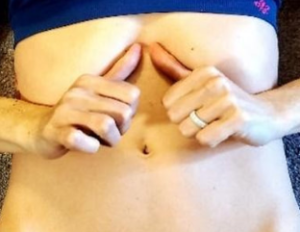
Basic Causes and Solutions for True Rib Flare
Both tipped up rib flare and infrasternal rib flare can be caused by:
- Pregnancy – the body’s attempt to make room for a growing fetus. Consider that an enlarging uterus will both elevate the diaphragm about 4cm and “as pregnancy proceeds, the subcostal angle widens from 68° to 103°.”[7] Changes like these can be considered “normal” in pregnancy, however, they are also changes that may or may not return to prior status.
- Weak/dysfunctional Abdominals/Obliques[8] (possibly along with tight lower back muscles) – Since extended exhales that focus on activating the external obliques are one solution, weakness (under-activation) of these muscles are a possible reason for why the ribs would flare in the first place.
- Weak/Dysfunctional Diaphragm – “If [the diaphragm] is not functioning optimally, the body may compensate by flaring out the ribs to help with respiration.”[9]
- Posture, in general – “An inherent pattern of asymmetry” affecting many humans from pelvis to ribs, including “left rib flare”[10]
| Solutions for Tipped Up Rib Flare | Solutions for Infrasternal Rib Flare |
|
|
Rib Breathing Anatomy & Physiology
When inhaling, the ribcage should expand in all directions and when exhaling the ribcage should compress in all directions.[13] In general, problems happen when the ribs don’t have good range of motion. One compensation is the classic “chest breather,” where inhalations tend to cause neck tension and rib cage elevation (rather than a balanced multidimensional expansion in “all directions.”
So let’s go more specific.
When inhaling, the front part of the ribs should naturally externally rotate and elevate[14,15] as they expand, which in and of itself could be called rib flaring. However, this amount of cyclic rib flaring can be considered to be in accordance with proper function. In other words, it’s part of the natural rib cage range of motion. Only if the anterior ribs were to become more regularly locked into this external rotation and elevation would it eventually come to be diagnosed as a rib flare of some sort.
The zone of apposition (ZOA) is the cylindrical area where the diaphragm is side by side in contact with the lower rib cage. This area is naturally variable, and can range from about half of the total surface area of the rib cage when maximally exhaling to zero when maximally inhaling.[16] Now, even though it’s variable, it still has a “tendency” of positioning, which can be too much, too little, or just right.

“The ZOA is important because it is controlled by the abdominal muscles and directs diaphragmatic tension. When the ZOA is decreased or suboptimal, there are several potential negative consequences.”[18] And wouldn’t you know, one of the main ways to decrease the ZOA is to have a rib flare! These consequences range from inefficient breathing to decreased intra-abdominal pressure and abdominal activation, and various postural imbalances.[19]
|
Consider Rib Anatomy |
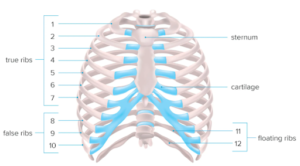 |
Reviewing the rib image above, consider that:
Imagining the actions of these muscles, in comparison to the kind of rib flare that you are seeing in your client, may help you design a program that is even more specific. Since the infrasternal angle (IAS) is formed by the cartilages of ribs 7-10,[24] this may call for a slightly different nuance in exhale or exercise selection, compared to a tipped up rib flare. The basic suggestion is:
|
Whether your client is rib thrusting or has a true rib flare, the basic problem is that the inner unit muscles may no longer have leverage to act as functionally as they would if the skeleton was in a better alignment. One of these muscles is the diaphragm, which may not be able to pull as concisely into the chamber. This can affect its communication with the abdominal and pelvic floor muscles, potentially leading to pelvic floor over- or under-activity. This of course affects one’s ability to maintain intra-abdominal pressure, and therefore your client’s ability to feel strong and remain free from back pain, heal diastasis, and more. It may even prevent your client from being able to feel like they can take a deep breath.
As an example, one of the Postural Restoration Institute’s seven fundamental concepts for treating postural disorders states specifically how this inner synchrony can affect walking, “The movement of the respiratory diaphragm and the pelvic diaphragm (pelvic floor muscles) is synchronized during breathing. The pelvis is a primary structure that facilitates gait. The synergistic activity of these two diaphragms links respiration and gait.”[25]
Remember, breathing is so absolutely critical to life, that it creates an extreme influence on the entire body, both muscularly[26] and internally,[27] for better or for worse.
How Rib Flaring (or thrusting) might be associated with various changes in the body:
- Back pain: To the degree that the abdominals are not doing their functional job, the back muscles will be more likely to activate, spasm, and/or feel pain.
- Any pain: As the core is less functional, it is reasonable that nearly any musculoskeletal ache, pain, or immobility could be associated with rib flaring.
- Digestion/Constipation: Since a rib flare indicates altered volume in the trunk cavity, as well as potential diaphragmatic shallowness, it is reasonable to say that rib flare can be associated with changes in things like digestion motility, including for example, constipation.
- Managing Stress / De-Stressing: Since the vagus nerve (VN) is the “main affector and effector” of the parasympathetic nervous system,[28] and “VN activity is modulated by respiration”[29], and “exhalation is under direct control of the VN,”[30] rib flaring could be a sign that the exhale portion of the breath is not being activated adequately.
- Pelvic Floor (PF): To the degree that rib flare disrupts the synchrony of the diaphragm and PF, PF function will be suboptimal. Physical therapist Seth Oberst, adds that in his experience with rib flare, a “tipped forward” pelvis commonly correlates with increased tension in the PF (which he sees in both men and women with pelvic pain).[31]
Rib Flare on the Left Side?
Rib flare is commonly thought to occur more on the left side due to a combination of factors like:
- The inside under our ribs is not identical on both sides, which is believed to be the reason why so many find the left ribs to flare more than the right.
- The right dome of the diaphragm (over the liver) is positioned slightly higher than the left dome (over the stomach).[32] These different obstacles for the diaphragm may lend themselves to pulling on the ribs with different length-tension relationships, and therefore different vigor, during each breath.
- Exercise physiologist and doula, Gina Conley, suggests a unique birth-related theory: “since the optimal position for our baby is left occiput anterior (tends to sit on the left side of the uterus), then this contributes to more restriction during pregnancy on the left side of the diaphragm.”[33]
Where does Rib Flare fit into your Programming?
- First, identify if your client has rib thrust or true rib flare! If your client has any kind of rib thrusting or flaring, it will clearly be important to educate her on some specific postural, breathing, and exercise-related changes. But, if rib flare isn’t present, feel good about moving into coaching other areas of fitness! As they say, “if it ain’t broke, don’t fix it.”
- Second, determine the importance that rib flare may be having on this specific client’s life. No doubt that proper breathing is of the highest importance, so it is very likely that addressing rib flare first is the thing to do. However, if she’s suffering terrible knee pain, maybe spend a few sessions on hip loading first!
- Third, Corrective Exercise 101: Determine which cue to teach first, rather than overwhelm her with all the cues. For example, will you be coaching her to bring her ribs down with each overhead reach, or with each exhale, or perhaps extending each exhale for several seconds?
If you are a Fit For Birth student or graduate, please continue reading “part 2” for an explanation of Rib Flaring in relation to Core Breathing.
—————————–
- Fitness & Wellness Professionals:
- 2 FREE CEU!
- CEC/CEU Courses, including our Pre & Postnatal Corrective Exercise Specialist (PPCES), the world’s first holistic perinatal CEC/CEU!
- Monthly Elite Membership – Community. Monthly education. Business mentorship & work opportunities. $27/month.
- Pregnancy, Pre-conception & Postpartum:
—————————————————-
James Goodlatte is a Father, Holistic Health Coach, Corrective Exercise Practitioner, Speaker, Author, Professional Educator, and the founder of Fit For Birth and Exercise For Longevity. Since 2008, when he found out he would be a father, his passion for holistic wellness shifted to children and families. Today, he is a driving force in providing Continuing Education Credits for the pre and postnatal world, with Fit For Birth professionals in 52 countries. James is a contributing member of the First 1000 Days Initiative at the Global Wellness Institute, and longevity researcher & educator.
References
[1] Image: Musician’s Health Collective. http://www.musicianshealthcollective.com/blog/2015/12/9/what-does-rib-thrusting-look-like
[2] Image: Stacey Schaedler. https://staceyschaedler.com/
[3] N/A in 2/12/25 update
[4] N/A in 2/12/25 update
[5] 2015. Kim & Weon. Intra- and Inter-rater Reliabilities of Infrasternal Angle Measurement. Journal of Korean Physical Therapy. Retrieved 6/12/22 from http://www.kptjournal.org/journal/view.html?doi=10.18857/jkpt.2015.27.3.154
[6] Image: Connect PT. https://www.connectpt.org/blog/postpartum-rib-flare
[7] 2001. Campbell & Klocke. Implications for the Pregnant Patient. American Journal of Respiratory and Critical Care. Retrieved 6/12/22 from https://www.atsjournals.org/doi/full/10.1164/ajrccm.163.5.16353
[8] 2021 – Wong, Mark PT. How to fix Flared Ribs. Posture Direct. Retrieved 6/12/22 from https://www.posturedirect.com/flared-ribs/
[9] 2021 – Wong, Mark PT. How to fix Flared Ribs. Posture Direct. Retrieved 6/12/22 from https://www.posturedirect.com/flared-ribs/
[10] 2013. Boyle, Kyndall. Clinical application of the right sidelying respiratory left adductor pull back exercise. International Journal of Sports Physical Therapy. PubMed. Retrieved 6/14/22 from https://pubmed.ncbi.nlm.nih.gov/23772350/
[11] Note also that clients with an infrasternal angle less than 90° can be taught to increase this angle with extended lateral rib exhalations.
[12] 2021. Zolty, Bryn, PT. Postpartum Rib Flare. Connect Physical Therapy. Retrieved 6/12/22 from https://www.connectpt.org/blog/postpartum-rib-flare
[13] (n.d.) Zach Cupples. Stop bringing ribs down – do this instead. Retrieved 6/14/22 from https://zaccupples.com/stop-ribs-down/
[14] 2018. Getting a Handle on Our Ribs. Hands On Therapeutics. Retrieved 6/14/22 from http://www.handsonstl.org/blog/2018/4/7/getting-a-handle-on-our-ribs
[15] (n.d.) Hallinan, Neal. The Right BC Pattern. Retrieved 6/14/22 from https://pritrainer.com/right-bc-pattern/
[16] (n.d.) Zone of Apposition (ZOA). Postural Restoration Institute. Retrieved 6/14/22 from https://www.posturalrestoration.com/the-science/zone-of-apposition-zoa
[17] Image: Postural Restoration Institute. https://www.posturalrestoration.com/the-science/zone-of-apposition-zoa
[18] 2010. Boyle, Olinick, and Lewis. The Value of Blowing Up a Balloon. North American Journal of Sports Physical Therapy. NIH. NCBI. Retrieved 6/14/22 from https://www.ncbi.nlm.nih.gov/pmc/articles/PMC2971640/
[19] 2010. Boyle, Olinick, and Lewis. The Value of Blowing Up a Balloon. North American Journal of Sports Physical Therapy. NIH. NCBI. Retrieved 6/14/22 from https://www.ncbi.nlm.nih.gov/pmc/articles/PMC2971640/table/T1/
[20] Image: Medical News Today. https://www.medicalnewstoday.com/articles/how-many-ribs-do-humans-have#how-many
[21] 2022. Vaskovic, Jana. External Abdominal Oblique Muscle. KenHub. Retrieved 6/13/22 from https://www.kenhub.com/en/library/anatomy/external-abdominal-oblique-muscle
[22] 2021. Shahid, Shahab.Rectus Abdominis Muscle. KenHub. Retrieved 6/13/22 from https://www.kenhub.com/en/library/anatomy/rectus-abdominis-muscle
[23] 2022. Sendic, Gordana. Transversus Abdominis Muscle. KenHub. Retrieved 6/14/22 from https://www.kenhub.com/en/library/anatomy/transversus-abdominis-muscle
[24] (n.d.) Infrasternal angle; Subcostal angle – angulus infrasternalis. IMAIOS. Anatomy. Retrieved 6/12/22 from https://www.imaios.com/en/e-Anatomy/Anatomical-Parts/Infrasternal-angle-Subcostal-angle# “The infrasternal angle (subcostal angle) is formed in front of thoracic cage by the cartilages of the tenth, ninth, eighth, and seventh ribs, which ascend on either side, where the apex of which the xiphoid process projects.”
[25] 2017. Henning, Mangino, and Massé. Innovations in Spinal Deformities and Postural Disorders. Postural Restoration: A Tri-Planar Asymmetrical Framework for Understanding, Assessing, and Treating Scoliosis and Other Spinal Dysfunctions. In Tech Open. Retrieved June 11, 2022 from https://www.intechopen.com/chapters/55812
[26] 2017. Henning, Mangino, and Massé. Innovations in Spinal Deformities and Postural Disorders. Postural Restoration: A Tri-Planar Asymmetrical Framework for Understanding, Assessing, and Treating Scoliosis and Other Spinal Dysfunctions. In Tech Open. Retrieved June 11, 2022 from https://www.intechopen.com/chapters/55812
[27] 2022. Young, William. Endocrine Function. Merck Manual. Retrieved 6/14/22 from https://www.merckmanuals.com/home/hormonal-and-metabolic-disorders/biology-of-the-endocrine-system/endocrine-function “The amount of carbon dioxide exhaled, and consequently the pH of the blood, increases as breathing becomes faster and deeper”
[28] 2018. Gerritsen and Band. Breath of life: The respiratory Vagal stimulation model of contemplative activity. Frontiers in Human Neuroscience. NIH NCBI. Retrieved 6/12/22 from https://www.ncbi.nlm.nih.gov/pmc/articles/PMC6189422/
[29] 2018. Gerritsen and Band. Breath of life: The respiratory Vagal stimulation model of contemplative activity. Frontiers in Human Neuroscience. NIH NCBI. Retrieved 6/12/22 from https://www.ncbi.nlm.nih.gov/pmc/articles/PMC6189422/
[30] 2018. Gerritsen and Band. Breath of life: The respiratory Vagal stimulation model of contemplative activity. Frontiers in Human Neuroscience. NIH NCBI. Retrieved 6/12/22 from https://www.ncbi.nlm.nih.gov/pmc/articles/PMC6189422/
[31] 2015. Oberst, Seth. Guest Post: Rib cage position, breathing and your pelvic floor. Pelvic FLoor Physical Therapy Specialists in Metro Atlanta. Retrieved 6/12/22 from https://jessicarealept.com/2015/12/05/rib-cage-position-breathing-pelvic-floor/
[32] 2022. Gorman, Niamh. Diaphragm. Ken Hub. Retrieved 6/12/22 from https://www.kenhub.com/en/library/anatomy/diaphragm
[33] (n.d.) Conley, Gina. Finding Your Neutral Posture: The Ribs. Mamaste Fit. Retrieved 6/12/22 from https://mamastefit.com/2018-8-4-finding-your-neutral-posture-the-ribs/
